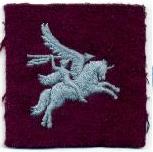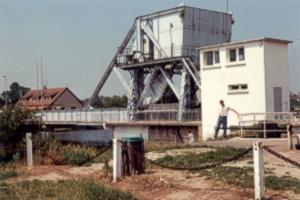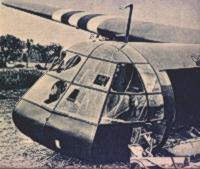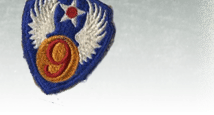British
airborne landings
 The
river Orne ran down to the Channel on the east side of the landing area,
at the bathing resort Ouistreham. The British 6th Airborne Divison would
land on the East side of the landing area, along the Orne river. The Airborne
division had several missions that needed to be completed in the night
before the sheduled landings from the sea. At Merville, east of the Orne
the Germans had build a costal battery. Allied intelligence believed that
the battery contained 4 guns of 155 mm. These guns where directly aimed
at Sword beach, where the 3rd British Infantry Division would land. The
bunkers could be blown by airial bombartment, so it was up to the 9th
Parachute battalion of the 6th Airborne division, to storm the defense
lines around the battery and disable the guns. The
river Orne ran down to the Channel on the east side of the landing area,
at the bathing resort Ouistreham. The British 6th Airborne Divison would
land on the East side of the landing area, along the Orne river. The Airborne
division had several missions that needed to be completed in the night
before the sheduled landings from the sea. At Merville, east of the Orne
the Germans had build a costal battery. Allied intelligence believed that
the battery contained 4 guns of 155 mm. These guns where directly aimed
at Sword beach, where the 3rd British Infantry Division would land. The
bunkers could be blown by airial bombartment, so it was up to the 9th
Parachute battalion of the 6th Airborne division, to storm the defense
lines around the battery and disable the guns.
Secondly the
airborne division had to prevent German reinforments from reaching the
beaches while the men on the beaches where in a vulnerable position, namely
during the landing. For this aim they had to blow up five bridges over
the river Dives, which lay 8 kilometres east of the river Orne.
The two bridges
over the river Orne near Benouville could not be destroyed because these
where vital for a quick expanding of the beachhead shortly after the first
landings. General Major Richard Gale desided that special assault sections
had to fly towards the bridges in gliders. They where sheduled to land
at eleven-fortyfive a few minutes before the pathfinders of the division
landed. These pathfinders would set out lights to mark the landing areas
on which the main force had to land.
 Six
horsa gliders and their towplanes left England at 23.00 on June 5. They
arried the 2nd battalion of the Oxford and Bucks light infantry and men
of the Royal Engineers. Their target were the bridge across the orne at
Ranville and the bridge across the Cean Channel. Five of the six gliders
landed right on target, they rammed the barbed wire defenseline and landed
almost agains the pillars of the bride. The men kicked and cut their way
out of the glider, through the thin canvas sides almost before the glider
had come to a full stop. It took a short fire fight but the German defenders
of the bridge where soon overwhelmed by the British that ran firing from
the hip across the bridges. The bridge at Benuoville would later become
known as Pegasus Bridge, after the symbol of the British paratroopers.
The engineers discovered the charges that the Germans had attached to
the bridge and dismantled them. Six
horsa gliders and their towplanes left England at 23.00 on June 5. They
arried the 2nd battalion of the Oxford and Bucks light infantry and men
of the Royal Engineers. Their target were the bridge across the orne at
Ranville and the bridge across the Cean Channel. Five of the six gliders
landed right on target, they rammed the barbed wire defenseline and landed
almost agains the pillars of the bride. The men kicked and cut their way
out of the glider, through the thin canvas sides almost before the glider
had come to a full stop. It took a short fire fight but the German defenders
of the bridge where soon overwhelmed by the British that ran firing from
the hip across the bridges. The bridge at Benuoville would later become
known as Pegasus Bridge, after the symbol of the British paratroopers.
The engineers discovered the charges that the Germans had attached to
the bridge and dismantled them.
Two of the sixty
pathfinders of the 6th airborne division had the misfortune to land inside
the headquarters of the 711st division. They apollogished to the German
commander for landing there by mistake. All the pathfinders had driven
more to the east than was initially intended by the planners. This brought
them dangerously close to the inundated areas and a large swamp. The pathfinders
didn't have the time to walk to the right landing areas before the main
force would arrive so they had t to place their signals where they where.
The landing of the
british main force would eventually be a little easier than the American
landing on the western side of the beachhead, but losses would still be
very high on the landing due to the fact that most paratroopers that landed
in the inundated areas with their heavy harnasess and all the equipment
couldn't cut themselves loose in time and drowned. They sometimes drowned
in water of a half metre deep simply because the heavy equipment and the
parachute dragged them under water.
 The
5th parachute brigade had to reinforce the men that had seized the bridges
by that time. The 8th battalion of the 3rd brigade received the assignment
to destroy the bridges across the Dives near Troarn and Bures. The 1st
Canadian battalion of the 3rd brigade had to blow the bridges at Robehomme
and Vareville. At Troarn a small group of paratroopers gathered
in one single jeep and drove into Troarn towards the bridge, firing to
all sides. The drove right through the German held town and blew the bridge
and then drove on in one spectacular action. At Robehomme the bridge was
blown by one single sergeant that had happened to have landed in the area.
The forces that had the mission to blow the bridges had been widely spread
and sometimes they had landed miles from their objective. However by the
brave acts of very small groups of men all the five bridges over the Dives
where destroyed that night. The
5th parachute brigade had to reinforce the men that had seized the bridges
by that time. The 8th battalion of the 3rd brigade received the assignment
to destroy the bridges across the Dives near Troarn and Bures. The 1st
Canadian battalion of the 3rd brigade had to blow the bridges at Robehomme
and Vareville. At Troarn a small group of paratroopers gathered
in one single jeep and drove into Troarn towards the bridge, firing to
all sides. The drove right through the German held town and blew the bridge
and then drove on in one spectacular action. At Robehomme the bridge was
blown by one single sergeant that had happened to have landed in the area.
The forces that had the mission to blow the bridges had been widely spread
and sometimes they had landed miles from their objective. However by the
brave acts of very small groups of men all the five bridges over the Dives
where destroyed that night.
The gliders
brought the reinforcements in that would be necessary to hold the bridges
at Ranville against a German counterattack. with the gliders came the
first ten anti tank guns. Out of the 72 gliders, 49 landed in the right
areas that had been cleared from obstacles. Casualties among the men that
landed by glider where light.
<<
BACK The
battery at Merville >>
|

 The
river Orne ran down to the Channel on the east side of the landing area,
at the bathing resort Ouistreham. The British 6th Airborne Divison would
land on the East side of the landing area, along the Orne river. The Airborne
division had several missions that needed to be completed in the night
before the sheduled landings from the sea. At Merville, east of the Orne
the Germans had build a costal battery. Allied intelligence believed that
the battery contained 4 guns of 155 mm. These guns where directly aimed
at Sword beach, where the 3rd British Infantry Division would land. The
bunkers could be blown by airial bombartment, so it was up to the 9th
Parachute battalion of the 6th Airborne division, to storm the defense
lines around the battery and disable the guns.
The
river Orne ran down to the Channel on the east side of the landing area,
at the bathing resort Ouistreham. The British 6th Airborne Divison would
land on the East side of the landing area, along the Orne river. The Airborne
division had several missions that needed to be completed in the night
before the sheduled landings from the sea. At Merville, east of the Orne
the Germans had build a costal battery. Allied intelligence believed that
the battery contained 4 guns of 155 mm. These guns where directly aimed
at Sword beach, where the 3rd British Infantry Division would land. The
bunkers could be blown by airial bombartment, so it was up to the 9th
Parachute battalion of the 6th Airborne division, to storm the defense
lines around the battery and disable the guns. Six
horsa gliders and their towplanes left England at 23.00 on June 5. They
arried the 2nd battalion of the Oxford and Bucks light infantry and men
of the Royal Engineers. Their target were the bridge across the orne at
Ranville and the bridge across the Cean Channel. Five of the six gliders
landed right on target, they rammed the barbed wire defenseline and landed
almost agains the pillars of the bride. The men kicked and cut their way
out of the glider, through the thin canvas sides almost before the glider
had come to a full stop. It took a short fire fight but the German defenders
of the bridge where soon overwhelmed by the British that ran firing from
the hip across the bridges. The bridge at Benuoville would later become
known as Pegasus Bridge, after the symbol of the British paratroopers.
The engineers discovered the charges that the Germans had attached to
the bridge and dismantled them.
Six
horsa gliders and their towplanes left England at 23.00 on June 5. They
arried the 2nd battalion of the Oxford and Bucks light infantry and men
of the Royal Engineers. Their target were the bridge across the orne at
Ranville and the bridge across the Cean Channel. Five of the six gliders
landed right on target, they rammed the barbed wire defenseline and landed
almost agains the pillars of the bride. The men kicked and cut their way
out of the glider, through the thin canvas sides almost before the glider
had come to a full stop. It took a short fire fight but the German defenders
of the bridge where soon overwhelmed by the British that ran firing from
the hip across the bridges. The bridge at Benuoville would later become
known as Pegasus Bridge, after the symbol of the British paratroopers.
The engineers discovered the charges that the Germans had attached to
the bridge and dismantled them.  The
5th parachute brigade had to reinforce the men that had seized the bridges
by that time. The 8th battalion of the 3rd brigade received the assignment
to destroy the bridges across the Dives near Troarn and Bures. The 1st
Canadian battalion of the 3rd brigade had to blow the bridges at Robehomme
and Vareville. At Troarn a small group of paratroopers gathered
in one single jeep and drove into Troarn towards the bridge, firing to
all sides. The drove right through the German held town and blew the bridge
and then drove on in one spectacular action. At Robehomme the bridge was
blown by one single sergeant that had happened to have landed in the area.
The forces that had the mission to blow the bridges had been widely spread
and sometimes they had landed miles from their objective. However by the
brave acts of very small groups of men all the five bridges over the Dives
where destroyed that night.
The
5th parachute brigade had to reinforce the men that had seized the bridges
by that time. The 8th battalion of the 3rd brigade received the assignment
to destroy the bridges across the Dives near Troarn and Bures. The 1st
Canadian battalion of the 3rd brigade had to blow the bridges at Robehomme
and Vareville. At Troarn a small group of paratroopers gathered
in one single jeep and drove into Troarn towards the bridge, firing to
all sides. The drove right through the German held town and blew the bridge
and then drove on in one spectacular action. At Robehomme the bridge was
blown by one single sergeant that had happened to have landed in the area.
The forces that had the mission to blow the bridges had been widely spread
and sometimes they had landed miles from their objective. However by the
brave acts of very small groups of men all the five bridges over the Dives
where destroyed that night.